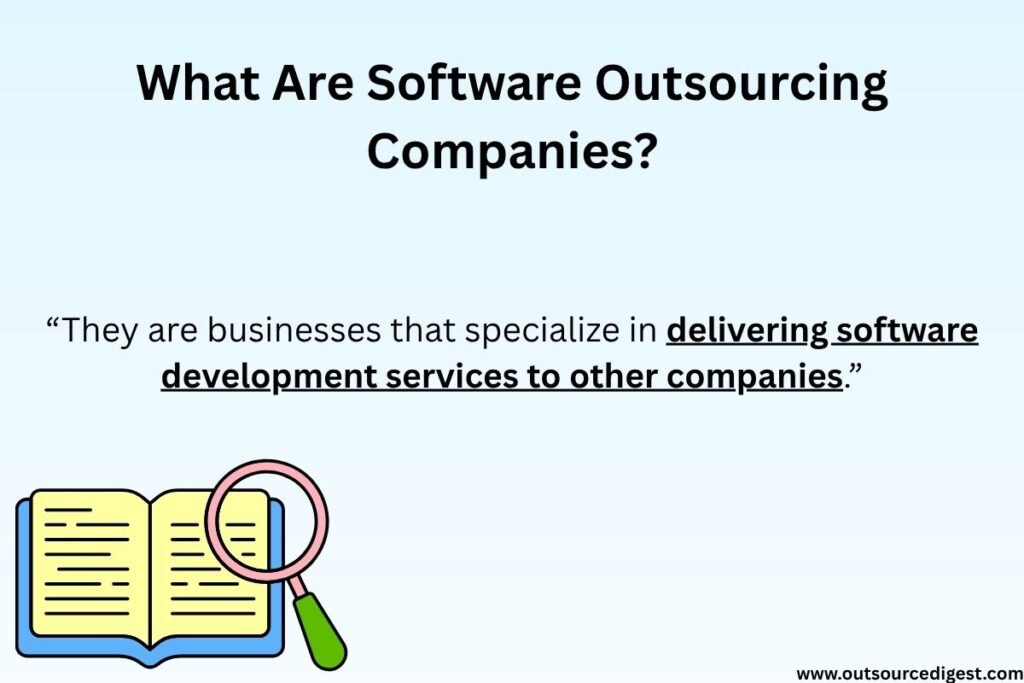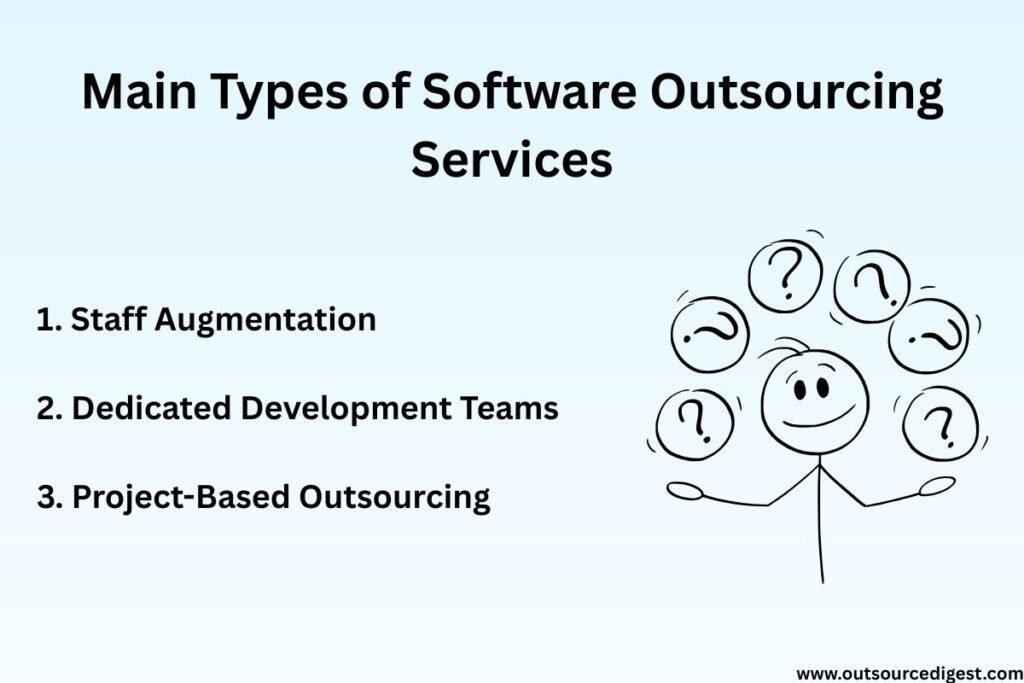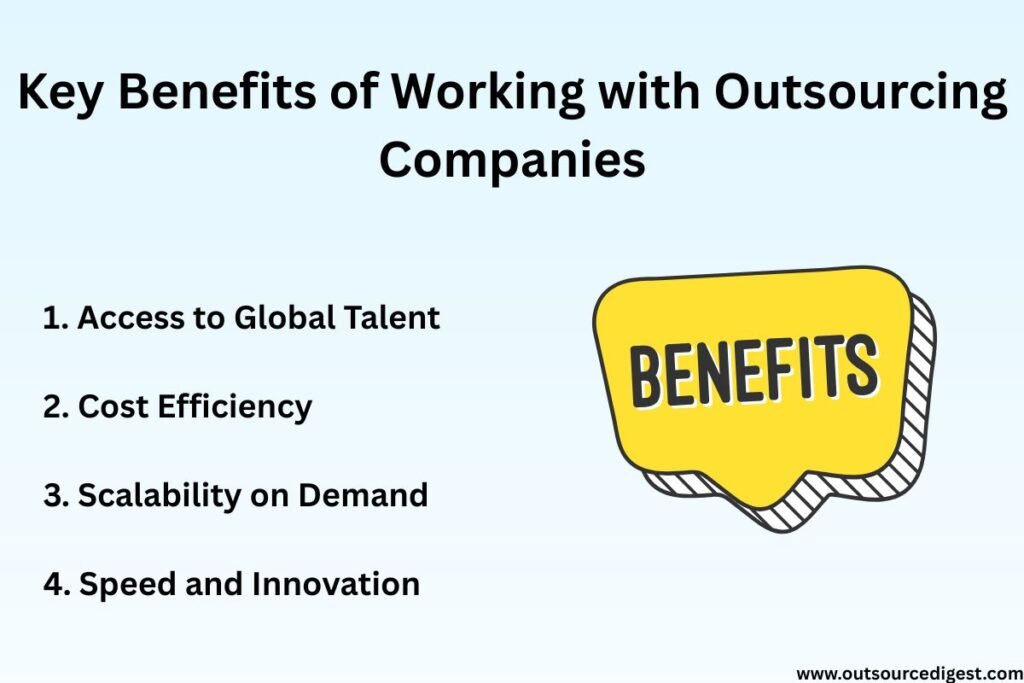Software outsourcing companies have become a global force, reshaping how businesses build, scale, and innovate their technology. This transformation is not only continuing—it’s accelerating. Startups, enterprises, and even government organizations are now relying on outsourcing partners to overcome talent shortages, reduce development costs, and deliver high-quality software solutions faster than ever before.
According to Gartner, global IT spending is projected to increase by 9.3 % to $5.74 trillion in 2025.
The rise of software outsourcing isn’t just a trend—it’s a strategic evolution. In 2025, global companies are no longer asking “Should we outsource?” but rather “How can we do it better?” This shift reflects a deeper recognition of outsourcing as a key driver for growth, flexibility, and competitive advantage in an increasingly digital world.
But what’s driving this global shift?
First, the demand for skilled tech talent continues to outpace supply in many Western countries. As a result, companies are turning to outsourcing partners in regions such as Eastern Europe, India, Latin America, and Southeast Asia to access skilled developers without exceeding their budgets. These regions have matured significantly over the last decade, offering not just affordable labor but also technical expertise, cultural compatibility, and high-quality infrastructure.
Second, the remote work revolution has erased geographic limitations. Businesses are now more comfortable managing distributed teams and adopting agile collaboration tools. This makes it easier than ever to integrate outsourced developers into existing workflows. Whether you need a single developer to augment your team or an entire remote squad to build a product from scratch, software outsourcing companies are equipped to step in and deliver.
Third, technological innovation is happening at an unprecedented rate. Artificial intelligence, cloud computing, cybersecurity, and DevOps practices are evolving rapidly. For most companies, keeping up with this pace in-house is challenging, expensive, and time-consuming. Outsourcing providers often specialize in specific domains, giving you access to up-to-date skills and tools without the overhead of building and maintaining those capabilities internally.
This ultimate 2025 guide to software outsourcing companies is designed to help you navigate this complex, yet opportunity-rich landscape. Inside, you’ll find:
- A clear explanation of what software outsourcing companies do
- The major outsourcing service models and how they work
- A breakdown of the top outsourcing regions around the world
- How to choose the right outsourcing partner for your business
- The latest trends shaping software outsourcing in 2025
Whether you’re a startup founder looking to build your MVP faster, a CTO trying to scale your engineering team, or a digital agency seeking backend support, this guide will give you the knowledge you need to make informed, confident outsourcing decisions.
By the end of this guide, you’ll not only understand the global outsourcing ecosystem—you’ll be ready to leverage it.
Let’s get started.
What Are Software Outsourcing Companies?
As Investopedia explains, outsourcing involves hiring external firms to handle specific business functions, most commonly software development.

The concept of software outsourcing companies is simple—they are businesses that specialize in delivering software development services to other companies. Instead of hiring full-time, in-house developers, many organizations choose to work with outsourcing partners to handle part or all of their software development needs. This approach allows them to scale quickly, stay flexible, and access global talent pools.
So, what exactly do software outsourcing companies offer?
These companies provide a wide range of services, covering nearly every stage of the software development lifecycle. From early product discovery and UI/UX design to backend development, QA testing, DevOps, cloud migration, and even post-launch support, outsourcing providers can manage it all. Depending on the company’s expertise, they may offer specific technical stacks (like JavaScript and Python), industry-specific solutions (like fintech or healthcare platforms), or specialized services like mobile app development or blockchain integrations.
In 2025, most software outsourcing companies operate as full-service technology partners. They no longer just “code what you ask.” Instead, they bring strategic value to the table. Many offer consulting services, project management, product roadmapping, and even business analysis to help clients turn ideas into scalable digital products. This is especially valuable for startups or non-technical founders who need more than just coding—they need guidance.
Now, let’s talk about who uses these companies.
The client base of software outsourcing providers is incredibly diverse. On one end of the spectrum, you have startups looking to build MVPs quickly and on a tight budget. These early-stage companies often can’t afford to hire a full in-house team, so outsourcing allows them to move fast and stay lean. Many successful startups today—from fintech apps to SaaS platforms—got their start by working with outsourcing firms.
On the other end, large enterprises and Fortune 500 companies also rely heavily on outsourcing. For them, it’s not about saving costs as much as it’s about efficiency and access to talent. These companies often outsource to fill skill gaps, support digital transformation, or launch innovation units. For example, a bank might work with an outsourcing firm to develop a secure mobile banking app or to modernize its backend infrastructure.
In between these two extremes, there are digital agencies, consulting firms, and SMBs (small to medium-sized businesses). Agencies often partner with outsourcing companies to extend their development capacity without hiring full-time staff. Meanwhile, SMBs use outsourcing to digitize operations, build customer-facing platforms, or automate internal workflows.
One of the most attractive aspects of working with software outsourcing companies is the flexibility they provide. Whether you need to hire a single developer through staff augmentation, build a dedicated development team, or hand off an entire project, outsourcing providers can adapt to your needs. This flexibility is crucial in a world where business requirements change quickly and development priorities shift overnight.
In short, software outsourcing companies have become essential partners in the modern business landscape. They combine technical expertise, cost-effectiveness, and global reach, allowing companies of all sizes to innovate faster and more affordably. Understanding what they do and how they operate is the first step toward building a successful outsourcing strategy.
Ready to explore the different service models these companies offer? Let’s dive into the next section.
Main Types of Software Outsourcing Services
When working with software outsourcing companies, one of the first things you’ll encounter is the variety of service models they offer. These models are designed to fit different business needs, budgets, and project scopes. Choosing the right one can make a significant difference in how efficiently your project moves forward, how much control you retain, and how much value you ultimately gain from the partnership.

Let’s take a closer look at the three most common outsourcing service models used in 2025: Staff Augmentation, Dedicated Development Teams, and Project-Based Outsourcing.
1. Staff Augmentation
In this model, the outsourcing company provides individual software developers or technical experts who integrate directly into your in-house team. These professionals work under your management and follow your internal processes, just like regular employees—only they’re remote and contracted.
This approach is ideal for businesses that need to quickly scale their development team without the hassle of recruitment, onboarding, or long-term commitments. For example, if your team lacks a front-end developer for a specific project or needs temporary support for a product launch, staff augmentation is a flexible and cost-effective solution.
One of the biggest advantages of staff augmentation is the ability to exert control. You retain full oversight of your team and project direction, while the outsourcing company handles HR, payroll, and talent sourcing.
2. Dedicated Development Teams
If your project requires a long-term, self-managed development team, this model is the right fit. A dedicated team works exclusively on your product, often including not just developers, but also project managers, QA testers, DevOps engineers, and UI/UX designers.
The outsourcing company assembles a handpicked team based on your technical needs and business goals. You collaborate with the team on roadmaps, milestones, and sprints, but they manage their own workflows, often using agile or scrum methodologies.
This model is especially effective for scaling tech startups, SaaS companies, or enterprises building large and complex platforms. You get the benefit of team consistency, deep product knowledge, and close collaboration, without the overhead costs of hiring and retaining an in-house team.
3. Project-Based Outsourcing
In this model, the entire responsibility for delivering a project is handed over to the outsourcing company. You provide the scope, requirements, and goals, and the partner handles everything else—from planning and development to QA and delivery.
This approach works well for companies that need to build a product but don’t have internal technical capabilities or prefer a hands-off approach. Common examples include building a mobile app, launching an e-commerce platform, or developing a custom CRM.
Project-based outsourcing is typically managed under fixed-price or milestone-based contracts. While it offers less control compared to the other models, it also removes operational complexity and shifts delivery responsibility to the vendor.
Software outsourcing companies provide flexible service models to match different levels of control, commitment, and collaboration. Whether you’re looking to extend your current team, build a long-term remote unit, or outsource an entire product, there’s a solution that fits.
Choosing the right model is critical to the success of your outsourcing journey, and in the next section, we’ll explore exactly why partnering with these companies can be so beneficial.
Key Benefits of Working with Outsourcing Companies
Partnering with software outsourcing companies in 2025 offers more than just cost savings. In today’s competitive business landscape, outsourcing has evolved into a strategic tool for gaining an edge, especially for companies that want to innovate fast, access specialized talent, and remain lean without compromising quality. Let’s dive into the key benefits that make outsourcing such a valuable option for businesses of all sizes.

1. Access to Global Talent
One of the most powerful advantages of working with software outsourcing companies is immediate access to a vast pool of skilled developers, designers, and technical specialists from around the world. Whether you’re searching for a React Native developer, a DevOps engineer, or an AI/ML expert, outsourcing gives you the freedom to choose from talent that’s not limited by your local job market.
This is especially important in regions like the U.S., where tech talent shortages are driving up salaries and delaying hiring cycles. Instead of spending months recruiting and training new staff, companies can plug into ready-to-go teams with proven experience. Top outsourcing firms often have deep benches of certified professionals who can join your project in days, not weeks.
Moreover, these global teams are used to working in distributed environments. They’re fluent in agile methodologies, remote collaboration tools, and asynchronous workflows, making them easy to integrate into your operations.
2. Cost Efficiency
Let’s be honest—cost still matters. And this is one of the main reasons why software outsourcing companies remain attractive, especially for startups and mid-sized businesses. By outsourcing, companies can save between 30% to 60% on development costs, depending on the region.
How? First, labor costs in outsourcing hotspots like India, Eastern Europe, and Southeast Asia are significantly lower than in the U.S. or Western Europe. Second, you save on operational overhead—no need to invest in office space, hardware, employee benefits, or long-term HR commitments.
But it’s not just about going cheap. Top outsourcing providers focus on delivering value, not just low prices. With the right partner, you’re not cutting corners—you’re maximizing ROI.
3. Scalability on Demand
Another huge benefit of outsourcing is scalability. Your business needs might change fast—maybe you’re launching a product earlier than expected, or need to pivot to a new tech stack. Hiring internally to meet these demands can be slow, costly, and risky.
Outsourcing solves this. You can scale your development team up or down based on real-time needs. Most software outsourcing companies offer flexible engagement models that let you add more developers, designers, or QA engineers without renegotiating long-term contracts.
This level of agility allows you to respond to market changes, customer feedback, or investor pressure without missing deadlines or overextending your internal resources.
4. Speed and Innovation
In today’s digital economy, speed is everything. Customers expect rapid product updates, fast bug fixes, and innovative features. Software outsourcing companies bring both speed and innovation to the table.
Because they work across multiple industries and clients, outsourcing teams stay on top of the latest frameworks, tools, and development practices. They can often recommend better, faster, or more cost-effective solutions than what your in-house team might consider. Plus, their streamlined workflows and experience with rapid development cycles help reduce time-to-market.
Many companies now outsource not just to save time, but to gain a competitive edge. Whether it’s building a proof of concept in two weeks, launching an MVP in 90 days, or integrating cutting-edge tech like AI or blockchain, outsourcing gives you the horsepower to move fast and smart.
In short, software outsourcing companies offer a blend of talent, affordability, scalability, and innovation that’s hard to match internally, especially in 2025. But to fully unlock these benefits, it’s crucial to choose the right partner in the right region.
Up next, we’ll explore the world’s top outsourcing destinations—and why certain countries have become global leaders in tech talent and software services.
Global Outsourcing Hubs
As businesses continue to explore global solutions, software outsourcing companies are no longer limited to a handful of regions. In 2025, multiple outsourcing hubs around the world offer unique advantages—whether you’re looking for cost-effective development, cutting-edge innovation, or time-zone compatibility. Understanding what each region brings to the table can help you make smarter decisions when choosing a software partner.
Let’s explore the leading outsourcing destinations: the United States, India, Eastern Europe, Latin America, and Southeast Asia.
🇺🇸 Why Choose Software Outsourcing Companies in the USA
While most people associate outsourcing with offshore teams, many businesses still prefer to work with outsourcing companies located in the United States. Why? Working with a U.S.-based partner often provides smoother collaboration, stronger legal protections, and minimal cultural or communication barriers.
American software outsourcing companies typically offer high-end services, especially in areas like AI development, cybersecurity, and enterprise-level software architecture. They’re also well-versed in compliance standards like HIPAA, SOC 2, and GDPR, which makes them a preferred choice for regulated industries such as healthcare and finance.
Another benefit is time-zone alignment for U.S.-based clients. Real-time collaboration is much easier, and face-to-face meetings are possible if needed. While the cost of outsourcing within the U.S. is higher than in other regions, many companies find the trade-off worthwhile, especially when project complexity or data sensitivity is high.
Discover the most trusted software outsourcing companies in the USA
🇮🇳 Why Choose Software Outsourcing Companies in India
India remains one of the most established and reliable outsourcing destinations in the world. It’s home to thousands of software outsourcing companies offering services in everything from web development and mobile apps to enterprise solutions and cloud integration.
India’s major strength is its massive talent pool. With over 5 million software professionals and a strong STEM education system, it’s one of the few countries that can scale large teams quickly and affordably. English fluency is also a major advantage, as most developers are comfortable communicating in English, reducing the risk of misunderstandings.
Indian firms are also experienced in working with Western clients and tend to offer very competitive pricing. While time-zone differences can be a challenge, many companies offer flexible working hours or overlap shifts to accommodate U.S. business hours.
Discover the most trusted software outsourcing companies in India
🇵🇱 Why Choose Software Outsourcing Companies in Eastern Europe
Eastern Europe—particularly countries like Poland, Ukraine, Romania, and Bulgaria—has become a tech powerhouse over the past decade. These regions combine strong technical education systems with a fast-growing community of developers, engineers, and IT specialists.
One of the main reasons to choose software outsourcing companies in Eastern Europe is quality. These teams are known for their technical depth, attention to detail, and ability to handle complex development projects. Most developers speak fluent English, and cultural compatibility with Western clients is very high.
In addition, Eastern Europe offers better time-zone overlap with both the U.S. and Western Europe, which improves communication and speeds up development cycles. Pricing is typically mid-range—more expensive than India, but more affordable than the U.S., making it a great balance between quality and cost.
🇧🇷 Why Choose Software Outsourcing Companies in Latin America
Latin America has quickly risen as a top nearshoring option for North American businesses. Countries like Brazil, Argentina, Colombia, and Mexico are home to many talented outsourcing providers, especially in the fields of software development, DevOps, and UI/UX design.
What makes Latin America attractive is its proximity to the U.S., both geographically and culturally. Time-zone alignment is almost perfect, which enables real-time communication without late-night meetings or delays. English proficiency is growing, and many developers are bilingual or fluent.
While costs in Latin America are slightly higher than in Southeast Asia or India, they’re still significantly lower than U.S. rates. The region is also known for its creativity and innovative approaches to product development, making it a good fit for startups and design-driven companies.
🇻🇳 Why Choose Software Outsourcing Companies in Southeast Asia
Southeast Asia, especially countries like Vietnam, the Philippines, and Indonesia, is emerging as a strong alternative to traditional outsourcing markets. These regions offer highly competitive pricing, rapidly developing tech talent, and government support for the IT sector.
Vietnam, in particular, has become a favorite for companies looking to outsource web and mobile app development. The country has a growing number of skilled engineers, many of whom are trained in international universities or have experience working with Western clients.
Southeast Asian software outsourcing companies also excel in communication and flexibility. Many firms prioritize English training and cross-cultural collaboration, making them easy to work with despite time-zone differences. If you’re looking for affordable rates without sacrificing quality, this region deserves a closer look.
Each outsourcing hub has its strengths, and the best fit depends on your project scope, budget, and desired collaboration style. In the next section, we’ll walk you through exactly how to evaluate a software outsourcing company before signing a contract, so you can avoid common pitfalls and make a smart decision.
How to Evaluate a Software Outsourcing Company
Choosing the right software outsourcing company can make or break your project. With thousands of vendors around the world promising high-quality development at competitive rates, the challenge isn’t finding one—it’s knowing how to evaluate them properly. In 2025, when innovation cycles are faster and global competition is fierce, your ability to assess potential outsourcing partners becomes a business-critical skill.
Here’s a practical guide to the key criteria you should use when evaluating any software outsourcing provider—plus some red flags to avoid along the way.
1. Technical Expertise and Tech Stack Compatibility
The first thing to evaluate is whether the company’s technical skills align with your project requirements. This goes beyond just checking their website for a long list of technologies. Instead, dig deeper:
- Have they completed similar projects in your industry?
- Can they demonstrate mastery in your required tech stack (e.g., React, Node.js, AWS, etc.)?
- Are they up to date with current trends such as AI integration, microservices, or cybersecurity?
Ask to review case studies, sample code, or even request a short technical assignment before committing to anything long-term. You want to see real evidence, not just marketing promises.
2. Communication and Project Management
Even the most talented team will fail if communication is weak. Effective outsourcing depends on clear, timely, and consistent collaboration. During the evaluation stage, pay close attention to:
- How responsive they are in early conversations.
- Whether they speak and write clear English.
- What project management tools do they use (e.g., Jira, Trello, Slack)?
- Whether they offer regular sprint planning, updates, or retrospectives.
A good software outsourcing company will provide you with a dedicated point of contact, a clear communication protocol, and full visibility into progress, blockers, and timelines.
3. Scalability and Team Structure
Your project may start small, but will the team be able to scale with you? It’s important to understand:
- How fast can they ramp up new resources?
- Whether they have access to in-house developers or rely on freelancers.
- If they assign specialists (e.g., QA testers, DevOps, UI/UX designers) when needed.
The best outsourcing companies offer flexible engagement models and can adapt to your changing needs without lengthy delays or renegotiations.
4. Security, Compliance, and IP Protection
Data security is a major concern when working with external teams, especially across borders. Before you sign anything, make sure the vendor:
- Follows best practices for data protection (e.g., encryption, access control).
- Has experience with your compliance requirements (e.g., HIPAA, GDPR).
- Is willing to sign strong non-disclosure agreements (NDAs).
- Clearly outlines IP ownership clauses in the contract.
Failure to address these areas could expose your business to legal or reputational risks down the line.
5. Pricing Transparency and Value
Cost is important—but so is clarity. A trustworthy software outsourcing company will provide detailed, transparent pricing models. This includes:
- Hourly or monthly rates by role.
- Clear breakdowns of what’s included (and what’s not).
- Estimates for total hours or milestones.
- Billing cycles and payment terms.
Watch out for vendors who promise unrealistically low prices without explaining how they’ll deliver quality work. If it sounds too good to be true, it probably is.
Red Flags to Watch For
Here are some warning signs that should make you pause—or walk away:
- Vague answers to technical questions.
- Overpromising delivery timelines.
- No clear documentation or process.
- Poor online reviews or lack of references.
- Pushy sales tactics or reluctance to sign NDAs.
A reliable partner won’t pressure you—they’ll focus on building trust.
For a more detailed checklist and expert tips on vendor selection, check out our FAQ on Vendor Selection and Management. It covers everything from negotiation strategies to long-term relationship building with outsourcing partners.
In the next section, we’ll explore the latest software outsourcing trends in 2025 and what they mean for your business.
Software Outsourcing Trends in 2025
Software outsourcing companies are evolving faster than ever. In 2025, companies that fail to adapt to current trends risk falling behind—not just in technology, but also in talent, delivery speed, and customer trust. Whether you’re a startup founder, a CTO, or a procurement officer, understanding these key shifts can help you make smarter, future-proof outsourcing decisions.
Let’s explore the most important trends reshaping the outsourcing industry this year.
3. AI and Automation Take the Lead
Artificial intelligence is no longer just a buzzword. In 2025, it’s a core component of how top software outsourcing companies operate. From automating QA testing to writing base-level code, AI tools like GitHub Copilot, ChatGPT, and Copilot X are now widely used to boost developer productivity and reduce costs.
More importantly, outsourcing firms are now offering AI-driven solutions to their clients as part of their core services. These include:
- Predictive analytics for e-commerce or healthcare.
- AI-powered chatbots and virtual assistants.
- Intelligent process automation for enterprise clients.
Clients are increasingly expecting outsourcing vendors to not only understand AI but to implement it creatively across projects. If your potential partner can’t show real AI use cases or working demos, they may not be ready for the future.
2. Stronger Focus on Cybersecurity
With cyberattacks on the rise, data protection has become a non-negotiable part of the outsourcing conversation. In 2025, clients are demanding a higher level of security assurance from their outsourcing partners.
Leading software outsourcing companies now invest heavily in:
- SOC 2 or ISO 27001 certifications.
- Secure DevOps (DevSecOps) practices.
- Dedicated security teams for vulnerability testing and audits.
- Training programs to reduce human error and phishing risks.
Outsourcing partners that can demonstrate mature cybersecurity processes are becoming more attractive to enterprise-level clients, especially in sensitive industries like fintech, healthcare, and government.
3. From Offshore to Nearshore: Time Zone Matters
One of the most noticeable shifts in 2025 is the growing preference for nearshoring. Companies in the U.S. are increasingly turning to outsourcing firms in Latin America, while Western European businesses are choosing partners in Eastern Europe.
Why? Real-time communication is becoming more critical than ever. Agile methodologies, daily stand-ups, and rapid iteration cycles require closer time zone alignment. Nearshoring enables:
- Easier collaboration.
- Faster feedback loops.
- Reduced risk of delays and miscommunication.
That doesn’t mean offshore outsourcing is dead—it’s just evolving. Many top offshore providers are now offering hybrid teams with partially local support or flexible working hours to remain competitive.
For a deep dive into nearshoring, check out our dedicated guide: Nearshore Outsourcing Model: The Complete Guide (2025).
4. Client Expectations Are Rising
Today’s outsourcing clients are more educated, experienced, and selective than ever before. They expect more than just lines of code—they want strategic partners who can contribute to business outcomes.
This means software outsourcing companies need to:
- Offer proactive consulting, not just reactive delivery.
- Demonstrate ROI through KPIs and performance metrics.
- Provide transparency at every stage of the development lifecycle.
Outsourcing relationships in 2025 are built on value creation, not just labor savings. Vendors that don’t meet this expectation are being replaced quickly.
5. Hybrid Work Is the Norm
Remote work is no longer a temporary solution—it’s the standard model. As a result, the distinction between “in-house” and “outsourced” teams is starting to blur. Many companies are blending internal and external resources into hybrid agile teams.
Successful outsourcing vendors are adapting by:
- Offering seamless integration with in-house teams.
- Providing full-stack developers who can work independently.
- Using collaboration tools like Slack, Zoom, Notion, and Jira to stay fully synced.
This new flexibility allows clients to scale faster while maintaining full control over quality and culture.
In short, the software outsourcing landscape in 2025 is driven by intelligence, security, and agility. Businesses that recognize and act on these trends will be in a stronger position to innovate, compete, and grow.
In the final section of this guide, we’ll wrap up everything we’ve covered—and show you where to go next, including how to explore our curated directory of trusted outsourcing companies.
Final Thoughts
As we’ve explored in this guide, working with software outsourcing companies is no longer just a cost-saving tactic—it’s a strategic move that can unlock innovation, speed up development, and help businesses of all sizes stay competitive.
Whether you’re a startup founder looking to scale quickly, an enterprise CTO managing complex systems, or an agency trying to deliver more with limited internal resources, outsourcing offers a way to access world-class talent without the overhead of traditional hiring.
What This Guide Covers
Let’s quickly recap what we’ve explored in this complete 2025 guide:
- We started with a definition of software outsourcing companies and the services they typically offer, including staff augmentation, dedicated teams, and project-based delivery models.
- We looked at the advantages of outsourcing, from gaining access to global talent pools and reducing costs, to improving scalability and accelerating innovation.
- We explored global outsourcing regions, highlighting the strengths of providers in the U.S., India, Eastern Europe, Latin America, and Southeast Asia.
- We broke down how to choose the right partner, with tips on evaluating technical capabilities, communication practices, pricing models, and red flags to avoid.
- We reviewed the top trends of 2025, including AI integration, cybersecurity readiness, and the shift toward nearshore engagement and hybrid teams.
This isn’t just theory—it’s a framework you can use right now to make informed decisions and avoid the most common outsourcing mistakes.
If you’re still not sure which direction to take, we’ve got you covered.
Start Exploring: The OutsourceDigest Directory
We know how overwhelming it can be to choose the right vendor. That’s why we’ve created a carefully curated Outsourcing Companies Directory, built to help find trusted outsourcing companies that fit your needs.
Click here to explore our Software Outsourcing Companies Directory
This resource is regularly updated to reflect the latest market changes and vendor reputations, so you’re always looking at the most reliable options available.
Need Help Choosing?
If you’re feeling stuck, we’re here to help. At OutsourceDigest, we don’t just publish content—we partner with decision-makers like you to navigate the outsourcing process. Whether you’re trying to narrow down a list of vendors, evaluate a proposal, or figure out which model suits your business best, just get in touch.
We can match you with top-rated software outsourcing companies based on your specific needs and goals.
Your Next Step Starts Here
Outsourcing isn’t about handing off work—it’s about building better software, faster, and smarter. Use the knowledge from this guide to evaluate opportunities, avoid common pitfalls, and build partnerships that truly drive growth.
Don’t leave it to chance. Take control of your outsourcing strategy today.







